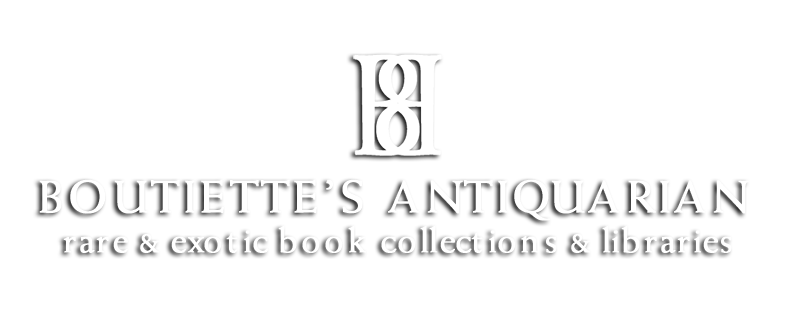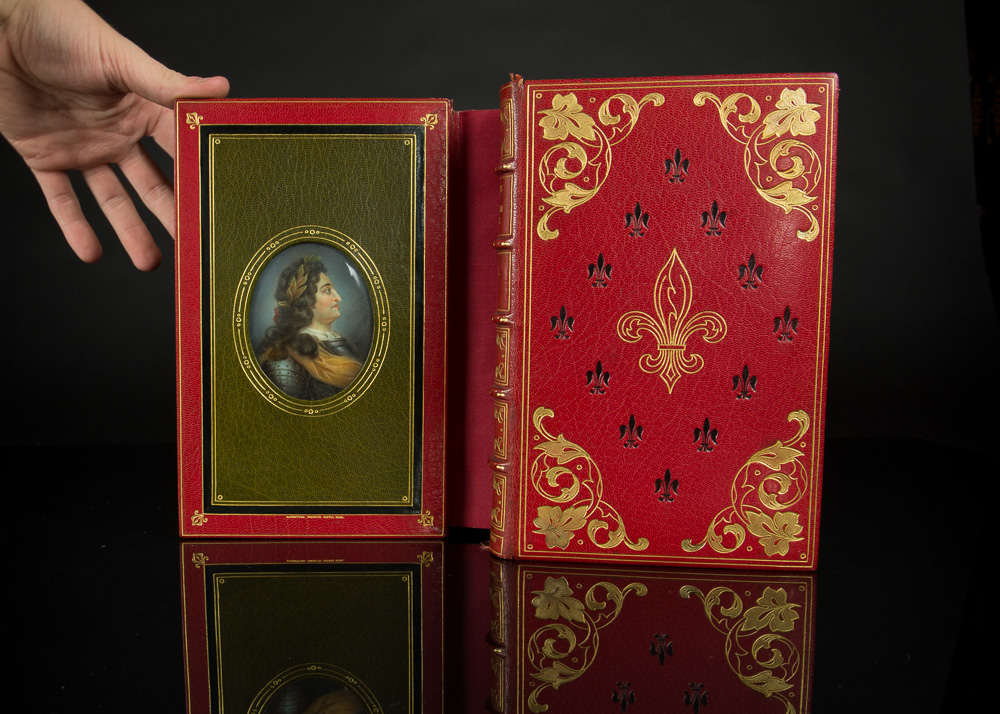The quality of bookbinding comes down to the quality of craftsmanship. The binding often is worth more than the book itself. Creating and designing bindings is time consuming and a unique form of art and, as this book demonstrates, has a value all its own. Even today, often the binding, not the writing, determines the value of a book. Throughout history books have been a treasure to many famous people. Different materials used in creating the bindings appealed to different taste. Monarchs became very involved and interested in bookbinding and even seem to have favorite types of bindings. Henry VIII was fond of beautiful leathers and velvet bindings. George III had a fondness for calf and sheep skin bindings. Napoleon was known to favor vellum. Queen Victoria was partial to inlayed and jewel encrusted bindings. Wealthy buyers preferred Moroccan leather styled with gold and elaborate designs. Often, price was of no concern to book collectors.
There were many sought-after craftsmen in bookbinding. Two superb craftsmen that immediately come to mind are William Edwards of Halifax and Roger Payne. Edwards specialized in Etruscan and vellum bindings. He created some of the finest, most beautifully simplistic bookbindings ever seen. In 1785 he patented a method of making vellum transparent and he and his sons revitalized the art of fore-edge painting. Payne, a native of Windsor and a London bookbinder, introduced richly tooled corner pieces and ornamental doublures. He also invented the graining of Morocco known as straight grain. Both Payne’s and Edwards’s books are in great demand to this day. As the number of bookbinders increased, lower and lower standards began to emerge. In response to this decline in quality, a group of artists and craftsman, led by William Morris, began to set up their own businesses designing and publishing books of a superior quality. This practice continued into the 1900s when many private book presses emerged. Although most of these private presses were more involved in the printing aspect of books, they were often associated with master binders. Today, these books command premium prices. The following are names of the more prominent private presses up to 1935, along with the year they were founded:
Appledore Press – 1870 in Connecticut
Argonau Press – 1926
Ashendene – 1894 by St.John Hornby
Ballantyne Press – 1796 by James Ballantyne
Beaumont Press – 1917. Specialized in hand-printed
editions.
Boars Head Press – 1930 by Sandford
Bremers Press – 1911
Cayme Press – 1923 by Humphrey Toulmin. Specialized
in heraldic and genealogical books.
Caradoc Press – 1899
Chiswick Press – 1811
Cloister Press – 1921 by Charles Hobson.
Clover Hill Press – 1931 by Douglas Cleverdon
Cranach Press – 1912 by Von Kessler
Cuala Press – 1903 by Elizabeth Corbert Yeats
Doves – 1900 by TJ. Cobden-Sanderson. Focused on
the beauty of the letterforms and structure of the letters.
Einhorn Press – 1909 by Melchior Lechters
Elston Press – 1900 by Clarke Conwell
Eragny Press – 1894 by Lucien Pissaro
Essex House Press – 1898 by C.R. Ashbee
Favil Press – 1920 by P. Sainsburg
Flying Fame Press – 1912 by Claude Lovat Fraser
Florence Press – 1908
Golden Cockerel Press – Founded in 1923, specializing
in the blending of text with original wood engravings.
Golden Cockerel produced some of the finest
illustrated books of the twentieth century, most notably
with The Canterbury Tales (1929 – 31) in four volumes.
Golden Hind Press – 1927 by Arthur Wisner Rushmore
Grabhorn Press – 1919 by Edwin & Robert Grabhorn
Gregynog Press – 1927 by D. Cohen & A. Myers
Hand and Flower Press – 1939
Harris Press – 1890 by Charles Harris
High House Press – 1924 by James Masters
Hogart Press – 1917 by L. and Virginia Woolf
Hours Press-1928 by Nancy Cunard
Kelmscott Press – 1891 by William Morris and Emery
Walker
Kunera Press – 1910
Mall Press – 1916 by Emery Walker
Marion Press – 1896 by Frank Hopkins, this was an
early American press.
Mosher Press – 1891 by Thomas Bird Mosher
Nonesuch Press – 1923 by Sir Francis Meynell. Dedicated
to making books as attractive as possible in a very
exclusive way.
Oriole Press – 1926 by Joseph !shill
Ovid Press – 1919 by John Rodker
Pear Tree Press – 1899 by James Guthrie
Pelican Press – 1916 by Francis Meynell
Perpetua Press – 1911 by David Bland
Polidori Press – 1840 by Gaetano Polidori
Purington Rollins Press – 1911 by Carl Purington
Rollins
Raven Press-1931
Riccardi Press – 1909
Rochester Press – 1888 by Henry Houghton
Roycroft Press – 1856 by Elbert Hubbard
Rupprecht Press – 1914 by Fritz Helmut Ehmcke
Sale Hill Press – 1904 by G. A. Hammond
Shakespeare Head Press – 1904 by A.H. Bullen.
Stanbrook Abbey Press – 1876 by Benedictine Monks
Swan Press – 1921 by Sydney Matthewman
Temple Sheen Press – 1911 by Arthur Sabin
Three Mountains Press – 1922 by William Bird
Trovillion Press – 1908 by Hal Trovillion
Unicorn Press – 1895 by Ernest Oldmeadow
Vale Press – 1894 by Charles Ricketts
Westminster Press – 1878 by Archibald Doughlas
Zilver Distel Press – 1910





